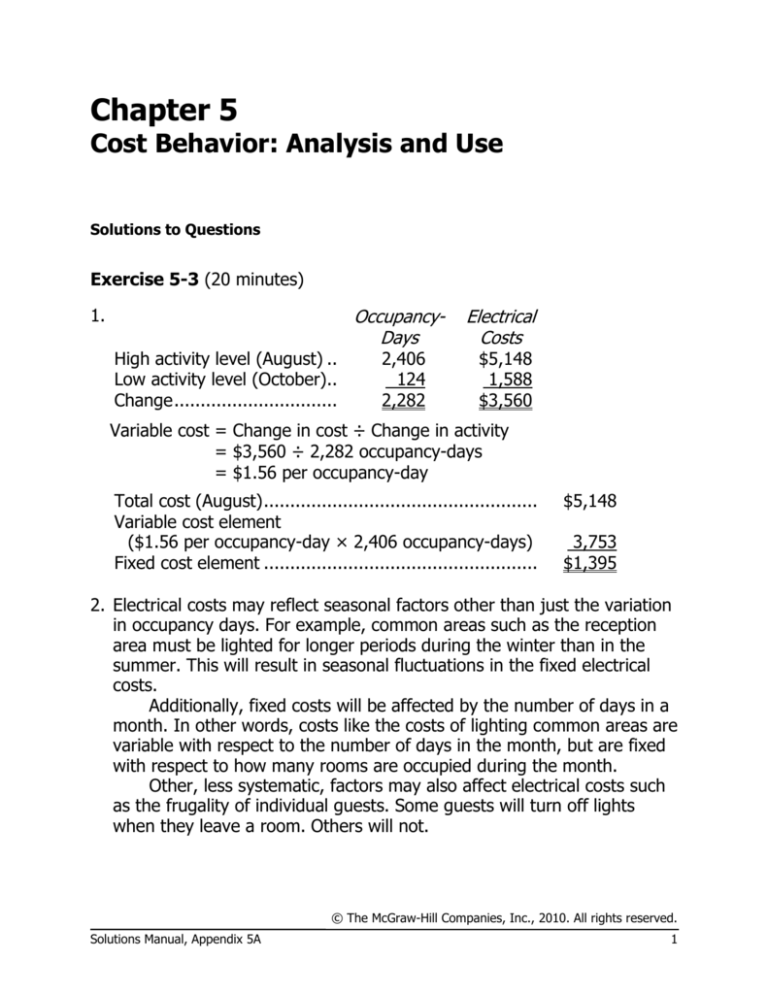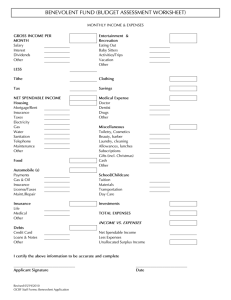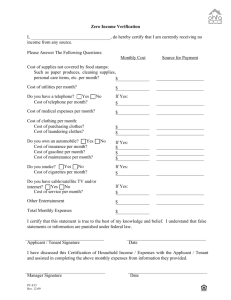
Chapter 5
Cost Behavior: Analysis and Use
Solutions to Questions
Exercise 5-3 (20 minutes)
1.
High activity level (August) ..
Low activity level (October)..
Change ...............................
OccupancyDays
2,406
124
2,282
Electrical
Costs
$5,148
1,588
$3,560
Variable cost = Change in cost ÷ Change in activity
= $3,560 ÷ 2,282 occupancy-days
= $1.56 per occupancy-day
Total cost (August) ....................................................
Variable cost element
($1.56 per occupancy-day × 2,406 occupancy-days)
Fixed cost element ....................................................
$5,148
3,753
$1,395
2. Electrical costs may reflect seasonal factors other than just the variation
in occupancy days. For example, common areas such as the reception
area must be lighted for longer periods during the winter than in the
summer. This will result in seasonal fluctuations in the fixed electrical
costs.
Additionally, fixed costs will be affected by the number of days in a
month. In other words, costs like the costs of lighting common areas are
variable with respect to the number of days in the month, but are fixed
with respect to how many rooms are occupied during the month.
Other, less systematic, factors may also affect electrical costs such
as the frugality of individual guests. Some guests will turn off lights
when they leave a room. Others will not.
© The McGraw-Hill Companies, Inc., 2010. All rights reserved.
Solutions Manual, Appendix 5A
1
Exercise 5-4 (20 minutes)
1.
The Alpine House, Inc.
Income Statement—Ski Department
For the Quarter Ended March 31
Sales ....................................................................
Variable expenses:
Cost of goods sold (200 pairs* × $450 per pair) ...
Selling expenses (200 pairs × $50 per pair) ..........
Administrative expenses (20% × $10,000) ...........
Contribution margin ...............................................
Fixed expenses:
Selling expenses
[$30,000 – (200 pairs × $50 per pair)] ..............
Administrative expenses (80% × $10,000) ...........
Net operating income ............................................
$150,000
$90,000
10,000
2,000
20,000
8,000
102,000
48,000
28,000
$ 20,000
*$150,000 ÷ $750 per pair = 200 pairs
2. Since 200 pairs of skis were sold and the contribution margin totaled
$48,000 for the quarter, the contribution of each pair of skis toward
covering fixed costs and toward earning of profits was $240 ($48,000 ÷
200 pairs = $240 per pair). Another way to compute the $240 is:
Selling price per pair ..........................
Variable expenses:
Cost per pair ...................................
Selling expenses..............................
Administrative expenses
($2,000 ÷ 200 pairs).....................
Contribution margin per pair ...............
$750
$450
50
10
510
$240
© The McGraw-Hill Companies, Inc., 2010. All rights reserved.
2
Managerial Accounting, 13th Edition
Exercise 5-5 (20 minutes)
1. The company’s variable cost per unit is:
$180,000
=$6 per unit.
30,000 units
In accordance with the behavior of variable and fixed costs, the
completed schedule is:
Total costs:
Variable costs ............
Fixed costs ................
Total costs .................
Cost per unit:
Variable cost ..............
Fixed cost ..................
Total cost per unit ......
Units produced and sold
30,000
40,000
50,000
$180,000
300,000
$480,000
$ 6.00
10.00
$16.00
$240,000 $300,000
300,000 300,000
$540,000 $600,000
$ 6.00
7.50
$13.50
$ 6.00
6.00
$12.00
2. The company’s income statement in the contribution format is:
Sales (45,000 units × $16 per unit) ........................
Variable expenses (45,000 units × $6 per unit) .......
Contribution margin...............................................
Fixed expense .......................................................
Net operating income ............................................
$720,000
270,000
450,000
300,000
$150,000
© The McGraw-Hill Companies, Inc., 2010. All rights reserved.
Solutions Manual, Appendix 5A
3
Exercise 5-7 (20 minutes)
1.
High level of activity .........................
Low level of activity ..........................
Change ............................................
Kilometers Total Annual
Driven
Cost*
105,000
70,000
35,000
$11,970
9,380
$ 2,590
* 105,000 kilometers × $0.114 per kilometer = $11,970
70,000 kilometers × $0.134 per kilometer = $9,380
Variable cost per kilometer:
Change in cost
$2,590
=
=$0.074 per kilometer
Change in activity 35,000 kilometers
Fixed cost per year:
Total cost at 105,000 kilometers .....................
Less variable portion:
105,000 kilometers × $0.074 per kilometer ..
Fixed cost per year ........................................
$11,970
7,770
$ 4,200
2. Y = $4,200 + $0.074X
3. Fixed cost .........................................................
Variable cost:
80,000 kilometers × $0.074 per kilometer ........
Total annual cost ...............................................
$ 4,200
5,920
$10,120
© The McGraw-Hill Companies, Inc., 2010. All rights reserved.
4
Managerial Accounting, 13th Edition
Exercise 5-8 (20 minutes)
1.
High activity level (July) ...............
Low activity level (March) ............
Change .......................................
Custodial
Guest- Supplies
Days Expense
12,000
4,000
8,000
$13,500
7,500
$ 6,000
Variable cost element:
Change in expense
$6,000
=
=$0.75 per guest-day
Change in activity 8,000 guest-days
Fixed cost element:
Custodial supplies expense at high activity level ....
Less variable cost element:
12,000 guest-days × $0.75 per guest-day ..........
Total fixed cost ....................................................
$13,500
9,000
$ 4,500
The cost formula is $4,500 per month plus $0.75 per guest-day or
Y = $4,500 + $0.75X
2. Custodial supplies expense for 11,000 guest-days:
Variable cost:
11,000 guest-days × $0.75 per guest-day .
Fixed cost ..................................................
Total cost ...................................................
$ 8,250
4,500
$12,750
© The McGraw-Hill Companies, Inc., 2010. All rights reserved.
Solutions Manual, Appendix 5A
5
Problem 5-11 (45 minutes)
1.
Marwick’s Pianos, Inc.
Income Statement
For the Month of August
Sales (40 pianos × $3,125 per piano) ...............
Cost of goods sold
(40 pianos × $2,450 per piano) .....................
Gross margin ..................................................
Selling and administrative expenses:
Selling expenses:
Advertising ................................................
Sales salaries and commissions
[$950 + (8% × $125,000)] ......................
Delivery of pianos
(40 pianos × $30 per piano).....................
Utilities ......................................................
Depreciation of sales facilities .....................
Total selling expenses ...................................
Administrative expenses:
Executive salaries .......................................
Insurance ..................................................
Clerical
[$1,000 + (40 pianos × $20 per piano)] ...
Depreciation of office equipment.................
Total administrative expenses ........................
Total selling and administrative expenses ..........
Net operating income ......................................
$125,000
98,000
27,000
$
700
10,950
1,200
350
800
14,000
2,500
400
1,800
300
5,000
19,000
$ 8,000
© The McGraw-Hill Companies, Inc., 2010. All rights reserved.
6
Managerial Accounting, 13th Edition
Problem 5-11 (continued)
2.
Marwick’s Pianos, Inc.
Income Statement
For the Month of August
Sales (40 pianos × $3,125 per piano) .................
Variable expenses:
Cost of goods sold
(40 pianos × $2,450 per piano) ....................
Sales commissions (8% × $125,000) ...............
Delivery of pianos (40 pianos × $30 per piano)
Clerical (40 pianos × $20 per piano) ................
Total variable expenses ......................................
Contribution margin...........................................
Fixed expenses:
Advertising .....................................................
Sales salaries ..................................................
Utilities...........................................................
Depreciation of sales facilities ..........................
Executive salaries ...........................................
Insurance .......................................................
Clerical ...........................................................
Depreciation of office equipment .....................
Total fixed expenses ..........................................
Net operating income ........................................
Total
Per
Piano
98,000
10,000
1,200
800
110,000
15,000
2,450
250
30
20
2,750
$ 375
$125,000
$3,125
700
950
350
800
2,500
400
1,000
300
7,000
$ 8,000
3. Fixed costs remain constant in total but vary on a per unit basis
inversely with changes in the activity level. As the activity level
increases, for example, the fixed costs will decrease on a per unit basis.
Showing fixed costs on a per unit basis on the income statement might
mislead management into thinking that the fixed costs behave in the
same way as the variable costs. That is, management might be misled
into thinking that the per unit fixed costs would be the same regardless
of how many pianos were sold during the month. For this reason, fixed
costs generally are shown only in totals on a contribution format income
statement.
© The McGraw-Hill Companies, Inc., 2010. All rights reserved.
Solutions Manual, Appendix 5A
7
Problem 5-13 (30 minutes)
1. a. 3
b. 6
c. 11
d. 1
e. 4
f. 10
g. 2
h. 7
i. 9
2. Without an understanding of the underlying cost behavior patterns, it
would be difficult, if not impossible, for a manager to properly analyze
the firm’s cost structure. The reason is that all costs don’t behave in the
same way. One cost might move in one direction as a result of a
particular action, and another cost might move in an opposite direction.
Unless the behavior pattern of each cost is clearly understood, the
impact of a firm’s activities on its costs will not be known until after the
activity has occurred.
© The McGraw-Hill Companies, Inc., 2010. All rights reserved.
8
Managerial Accounting, 13th Edition
Problem 5-17 (45 minutes)
1. Maintenance cost at the 90,000 machine-hour level of activity can be
isolated as follows:
Total factory overhead cost ........
Deduct:
Utilities cost @ $0.80 per MH* .
Supervisory salaries ................
Maintenance cost ......................
Level of Activity
60,000 MHs 90,000 MHs
$174,000
$246,000
48,000
21,000
$105,000
72,000
21,000
$153,000
*$48,000 ÷ 60,000 MHs = $0.80 per MH
2. High-low analysis of maintenance cost:
High activity level ....................
Low activity level .....................
Change ...................................
Machine- Maintenance
Hours
Cost
90,000
60,000
30,000
$153,000
105,000
$ 48,000
Variable rate:
Change in cost
$48,000
=
= $1.60 per MH
Change in activity
30,000 MHs
Total fixed cost:
Total maintenance cost at the high activity level ..
Less variable cost element
(90,000 MHs × $1.60 per MH) .........................
Fixed cost element ............................................
$153,000
144,000
$ 9,000
Therefore, the cost formula for maintenance is $9,000 per month plus
$1.60 per machine-hour or
Y = $9,000 + $1.60X.
© The McGraw-Hill Companies, Inc., 2010. All rights reserved.
Solutions Manual, Appendix 5A
9
Problem 5-17 (continued)
3.
Utilities cost ....................
Supervisory salaries cost ..
Maintenance cost ............
Total overhead cost .........
Variable Cost per
Machine-Hour
$0.80
1.60
$2.40
Fixed Cost
$21,000
9,000
$30,000
Thus, the cost formula would be: Y = $30,000 + $2.40X.
4. Total overhead cost at an activity level of 75,000 machine-hours:
Fixed costs.................................................
Variable costs: 75,000 MHs × $2.40 per MH
Total overhead costs ...................................
$ 30,000
180,000
$210,000
© The McGraw-Hill Companies, Inc., 2010. All rights reserved.
10
Managerial Accounting, 13th Edition
Appendix 5A
Least-Squares Regression Computations
Exercise 5A-1 (45 minutes)
The least-squares regression estimates of fixed and variable costs can be
computed using any of a variety of statistical and mathematical software
packages or even by hand. The solution below uses Microsoft® Excel as
illustrated in the text.
© The McGraw-Hill Companies, Inc., 2010. All rights reserved.
Solutions Manual, Appendix 5A
11
Exercise 5A-1 (continued)
The intercept provides the estimate of the fixed cost element, $1,377 per
month, and the slope provides the estimate of the variable cost element,
$4.04 per rental return. Expressed as an equation, the relation between car
wash costs and rental returns is
Y = $1,377 + $4.04X
where X is the number of rental returns.
Note that the R2 is 0.90, which is quite high, and indicates a strong
linear relationship between car wash costs and rental returns.
© The McGraw-Hill Companies, Inc., 2010. All rights reserved.
12
Managerial Accounting, 13th Edition
Exercise 5A-1 (continued)
While not a requirement of the exercise, it is always a good idea to plot the
data on a scattergraph. The scattergraph can help spot nonlinearities or
other problems with the data. In this case, the regression line (shown
below) is a reasonably good approximation to the relationship between car
wash costs and rental returns.
$18,000
$16,000
$14,000
Car Wash Costs
$12,000
$10,000
$8,000
$6,000
$4,000
$2,000
$0
0
1,000
2,000
3,000
4,000
Rental Returns
© The McGraw-Hill Companies, Inc., 2010. All rights reserved.
Solutions Manual, Appendix 5A
13
Exercise 5A-2 (30 minutes)
1.
Week
1
2
3
4
5
6
Units (X) Total Etching Cost (Y)
4
3
8
6
7
2
SFr18
SFr17
SFr25
SFr20
SFr24
SFr16
Statistical software or a spreadsheet application such as Excel can be
used to compute the slope and intercept of the least-squares regression
line for the above data. The results are:
Intercept (fixed cost) .................. SFr12.32
Slope (variable cost per unit) ....... SFr1.54
R2 ..............................................
0.94
Therefore, the cost formula is SFr12.32 per month plus SFr1.54 per unit
etched or
Y = SFr12.32 + SFr1.54
Note that the R2 is 0.94, which means that 94% of the variation in
etching costs is explained by the number of units etched. This is a very
high R2 and indicates a good fit.
2. Y = SFr12.32 + SFr1.54X
3. Total expected etching cost if 5 units are processed:
Variable cost: 5 units × SFr1.54 per unit ..
Fixed cost ..............................................
Total expected cost .................................
SFr 7.70
12.32
SFr20.02
© The McGraw-Hill Companies, Inc., 2010. All rights reserved.
14
Managerial Accounting, 13th Edition





